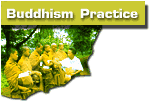 |
BANGKOK
|
||||||||
CENTRAL
|
||||||||||||
NORTHEASTERN
|
||||||||||||||
NORTHERN
|
||||||||||||
SOUTHERN
|
||||
 |
| A GUIDE TO MEDITATION CENTRES IN THAILAND |
| NORTHEASTERN - WAT DOI DHAMMA CHEDI |
MEANING
OF NAME : |
"The hill monastery of the Dhamma Chedi" |
ADDRESS
: |
Tambol Tong Khob, King Amper Khok Sri Suphan, Sakhon Nakhon 47280 |
DIRECTIONS
: |
Located 676 km northeast of Bangkok, 263 km north of Ubon Ratchathani, and 29 km southeast of Sakhon Nakhon.(Buses connect Sakhon Nakhon with Bangkok and most northeastern cities.) From Sakhon Nakhon, take a local bus or songtaew southeast 23 km on Hwy. 223 toward That Phanom; ask to be let off at Khok Sri Supan. Buses from Ubon Ratchathani to Sakhon Nakhon can also let you off here. Arrange transport south 6 km to Wat Doi Dhamma Chedi. Nearing the wat, you'll see rocky hills, then a concrete road that leads inside the grounds. |
MEDITATION
SYSTEM : |
: Ajahn Baen has experience with many systems. He most often teaches anapanasati or mental repetition of "Buddho" to establish concentration; one then contemplates the body and mind. Meditators are free to use their own techniques. |
TEACHING
METHOD : |
Occasional lectures and by asking questions. |
TEACHERS
: |
Ajahn Baen, abbot (Thai; age 63) |
LANGUAGE
: |
Visitors must speak good conversational Thai. The teacher and most other monks do not know English. |
DESCRIPTION
: |
The wat is built on and around a small wooded hill with views across the Maekhong Plain. The many sandstone boulders and outcrops add to the beauty. The main sala, at the end of the road, has an upstairs room used for meetings and eating; Ajahn Baen talks with visitors in the open area downstairs. Follow trails up the hill to see a large reclining Buddha and the bot. |
SIZE
: |
monks:
20-45 novices: 3-5 nuns: sometimes a few visiting laypeople: sometimes a few visiting |
DAILY
ROUTINE : |
Mostly left up to individual. Ajahn Baen encourages everyone to practice diligently. Regular group activities include pindabat, the meal, an afternoon drink, and work periods. Ajahn Baen holds meetings when appropriate, most often during the Rains Retreat and other occasions when new monks arrive. Chanting and group meditation take place during the Rains Retreat in mornings and occasionally in evenings (if a meeting is held). |
FOOD
: |
Very
good northeastern style. Monks and novices go on pindabat; other food
comes from the kitchen and donors. The community has one meal in the morning, served and eaten with the fingers. Monks, novices, and pakows eat upstairs in the main sala. Laypeople eat above the kitchen. |
ACCOMMODATIONS
: |
Monks
and novices stay in kutis tucked around rock outcrops in the central
area or scattered in the surrounding woods. Laymen can stay in kutis
if available. Laypeople have 2 large buildings east of the main sala;
one for women and nuns, the other for men. Women may feel more comfortable
if arriving and staying in groups of 2 or more. Bathrooms, separate
for men and women, have showers and Asian-style toilets. Bathrooms and large buildings have electricity; most kutis do not. |
WRITE
IN ADVANCE? : |
Recommended. The abbot likes to know such things as your name, country, and profession. |
OTHER
INFORMATION : |
Ajahn Baen places strong emphasis on practice.Disciplinary code and temple rules are of great importance too. Laypeople observe 8 precepts and dress modestly. One should avoid unnecessary conversation or wandering about too much. |
| Select here : |
|
|